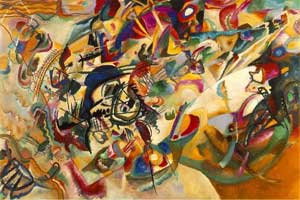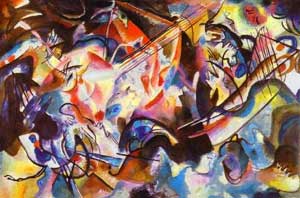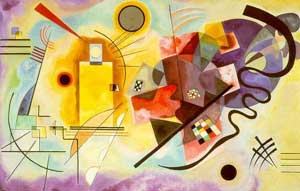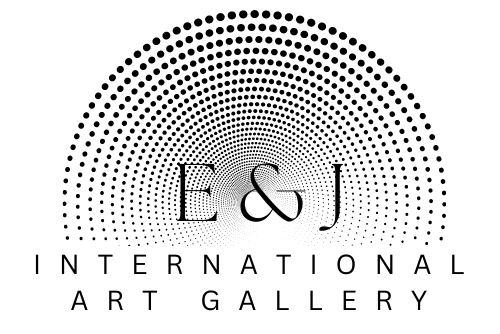Kandinsky, father of abstract art
Wassily Kandinsky (1866 - 1944) is hailed as the father of abstract art and the most influential art theorist of the 20th century. The Russian-born painter embarked on his artistic journey at the age of 30 with unparalleled enthusiasm. Despite starting late, he compensated with unmatched zeal. His paintings have the ability to "vibrate the soul" solely through the power of colors, without the need for recognizable objects. Amidst the political turmoil of his time, he had to contend with the intolerance of socialist regimes and Nazi Germany to defend his art. A tireless researcher, he endowed his work with an originality never devoid of idealism.
 Composition VII, 1913 - Oil on canvas (200 x 300 cm)
Composition VII, 1913 - Oil on canvas (200 x 300 cm)
"Pioneer of abstract art, Kandinsky is an indispensable name in modern art. Born in Moscow into a well-established family, he studied music and drawing in his youth... He pursued law and economics, but abandoned a legal career to dedicate himself to painting. At the age of 30, he decided to become an artist after admiring a work by Monet and being moved by the symphony of colors in Richard Wagner's opera 'Lohengrin.'"
"Apostle of color, he encountered artists such as Franz Marc, Lyonel Feininger, Paul Klee, and Alexei Von Jawlensky who shared a similar artistic vision."
"Kandinsky conceived abstract painting inspired by metaphysical ideas about the triumph of spirit over matter."
"He depicted apocalyptic motifs during World War I, and with the Russian Revolution, he explored painting without figures, a product of ideas and color. Later, in another phase, influenced by the surrealism of Hans Arp and Joan Miró, Kandinsky developed geometric paintings imbued with mysticism, replacing geometric figures with biomorphic forms. He summarized his Platonic conception of art: 'In my opinion, art is nothing more than the development of specific ideas, just as beings in nature are the definitive development of certain germs.'"
"'Painting is a tremendous clash of opposing worlds destined to create together, in struggle and from it, a new world called a work.'"
"For Kandinsky, the conventions of the past were exhausted; color and form are more genuine in expressing the artist's subjectivity than the object or perspective; the artist should not submit to the external, as their spirituality lies in the visionary nature of their work."
 Composition VI, 1913 - Oil on canvas (195 x 300 cm)
Composition VI, 1913 - Oil on canvas (195 x 300 cm)
"'Those who doubt the future of abstract art base their judgment on an evolutionary stage comparable to that of amphibians [...]; these do not represent the final result of creation, only its beginning.' Kandinsky"
"Kandinsky advocated the predominance of subjectivity in artistic work against any conventionalism. Far from being a formal or contentless work, his works attacked the pre-established codes for viewing art."
"In his spiritual quest, he achieved the abstraction of his painting, based on the expressive possibility of forms and colors. The synthesis with music, the correspondence between sounds and colors, was fundamental in the process. 'It is evident, therefore, that the harmony of colors must be based solely on the principle of effective contact. The human soul touched at its most sensitive point responds. We will call this base the Principle of Inner Necessity.'"
"He wrote 'Concerning the Spiritual in Art,' the first of his major theoretical works on painting. In it, he conducted a philosophical investigation into colors and forms, attributing psychological and moral values to them and comparing them to music, which, despite its immateriality, could 'vibrate the soul.'"
"He also published 'Point and Line to Plane,' about the practice of abstract painting, developing a theory similar to that used by musicians in composition. Kandinsky realized that behind his painting lay what truly interested him, as form always had secondary importance. In his works, one of his concerns was the search for an unstable balance between opposing elements."
In search of pure line
"Abstractionism, inaugurated by Kandinsky around 1910, presupposes the realization of an art independent of the external world and visible reality, that is, a work composed only of pure elements, such as forms, lines, and colors. Also called 'abstract art,' this movement developed in various directions until it became the predominant feature of all artistic production throughout the 20th century."
"Abstractionists radicalized a tendency typical of the main artistic vanguards of the late 19th and early 20th centuries. Since the invention of photography, impressionism had sought new ways to represent the world, distancing itself from the mere 'faithful' and 'immutable' reproduction of objects. The impressionists sought to capture the visual impressions caused by these same objects at a given moment, fleeting impressions that could vary according to the light, for example. By eliminating contours, impressionism produced paintings in which luminosity – rather than people or things – was the main theme of the painting."
 Yellow, red, blue, 1925 - Oil on canvas (128 x 201.5 cm)
Yellow, red, blue, 1925 - Oil on canvas (128 x 201.5 cm)
"'Post-impressionists and expressionists, in turn, liberated color and line from their merely representative functions, intentionally exaggerating forms to express the artist's emotion over the real world. The cubists, in their own way, also broke with the idea of art as imitation of nature by abandoning traditional notions of perspective and volume, portraying objects from multiple simultaneous viewpoints, decomposed into geometric figures."
"But to all these and other movements that sought a distancing and a rereading of the so-called 'objective world,' abstractionism opposed a radical refusal of any kind of representation. In other words, it was no longer about seeing the objects of the world with new eyes, but about creating a separate universe, an autonomous reality, created by the artist themselves. This is what Kandinsky meant by one of his most famous phrases: 'To create a work of art is to create a world.'"

